Beneath the ground between the Capitol and the three Senate office buildings runs a unique transportation system. Two subway lines shuttle senators and staff between their offices and the Senate wing of the Capitol. The subway system has undergone numerous changes since the Senate’s first office building opened in 1909, and while it has served its main purpose of allowing lawmakers to travel quickly to the Senate Chamber for votes, it has also become a popular Senate attraction.
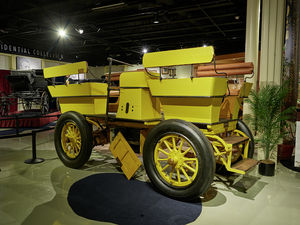
During the late 19th century, senators occupied offices in the Capitol, in the nearby Maltby Building (also known as the Senate Annex), and in other rented space on Capitol Hill. When Congress approved a proposal to construct a new building to provide all members with office space, the plans included subterranean tunnels and a rail system to deliver senators to the Capitol. Concerned about construction costs and potential public criticism that a rail line would be seen as a luxury, the commission in charge of the project scrapped the proposed subway.1
The 760-foot tunnel from the newly constructed Senate office building (named for Georgia senator Richard Russell in 1972) to the Capitol had been completed, however, and senators had grown fond of the prospect of some kind of transportation to and from the Capitol. When the building opened in 1909, Capitol Superintendent Elliott Woods arranged for two custom-built lemon-yellow electric battery-powered Studebaker cars to run in the underground tunnel. Each car could hold eight people plus an operator positioned in the center of the car on a reversible seat, avoiding the need for the car to turn around. While the cars could travel up to 12 miles per hour, they moved much more slowly in order to navigate the narrow, winding tunnel. Woods saw the cars as a temporary solution and consulted with Senate Rules Committee chairman Murray Crane of Massachusetts about other options. One possibility was to install a moving sidewalk. Woods also revisited plans for a rail system but warned that it would be quite noisy rumbling through the basement. In the end, the Senate opted to stick with the electric cars, which senators affectionately named “Tommy” and “Peg.”2
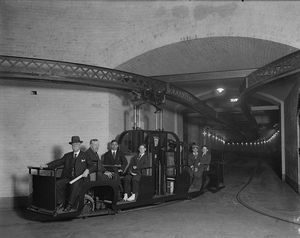
Senators found the Studebakers charming and useful, but they soon wanted a vehicle that could move more senators at faster speeds. In search of more efficient travel through the tunnel, engineers finally implemented the rail system, replacing the cars in 1912 with an electric monorail system consisting of a single car suspended from an overhead rail that provided the electricity. The rail car traveled one-way on a track that formed a loop in the basement of the office building rotunda. The monorail car was replaced with a new one in 1915, and an additional car was added in 1920. The new cars held 18 people each and moved at a top speed of eight miles per hour. The monorail line, referred to by senators as the “Toonerville Trolley” after the train station at the center of the then popular Toonerville Folks comic strip, operated for over 50 years.3
“The world’s shortest subway” became a popular attraction for visitors to the Capitol. President William Howard Taft decided in 1911 to make a detour from his usual walking route around the city to take a ride through the tunnel on one of the Studebakers (briefly causing a panic because he did not inform the White House that he was venturing underground and was thought to be missing.) In March 1914, the Boston Daily Globe reported that newlyweds George and Henrietta made their way to the subway tunnel for a joyride, taking six round trips, all while wearing their wedding attire.4
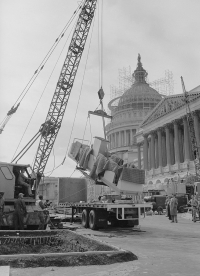
Despite its popularity, at least one senator was not pleased with the new system. In 1913 Senator William Stone of Missouri complained about the noise of the new cars and introduced a resolution to ditch the monorail and bring back the Studebakers. Senator John Bricker no doubt was glad the railway was there in 1947, however, when a disgruntled former Capitol police officer fired two gunshots at him. He was able to escape quickly by jumping into the car and telling the operator, “Let’s get out of here!”5
The construction of a second Senate office building in the late 1950s (named for Illinois senator Everett Dirksen in 1972) led to major changes to the subway system. In addition to a tunnel between the newest building and the Capitol, another tunnel was constructed to maintain the connection between the Capitol and the Russell Building. (The original tunnel was converted to space for the Senate recording studio.) In each tunnel, two lanes of track ran parallel to each other. Four new rail cars were purchased, each able to carry up to 18 passengers at a top speed of 20 miles per hour. At the opening of the new session in January 1960, Senator Dennis Chavez of New Mexico, who chaired the commission that oversaw the construction of the Dirksen Building, cut the ribbon and officially opened the new line to passengers. Senate Chaplain Frederick Brown Harris offered a blessing for what he called the “swift chariots of Democracy.” Chavez and Architect of the Capitol J. George Stewart climbed into one car for the maiden ride, while Senator Jennings Randolph of West Virginia boarded the second car with some journalists, and the two cars raced through the tunnel in what a Washington Post writer dubbed “the Capitol Hill version of Ben Hur,” referring to that film’s famous chariot race.6
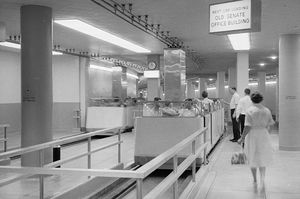
But once again, not all senators were happy with efforts to modernize the subway system. Arkansas senator J. William Fulbright stated that he preferred the old “Toonerville Trolley” system, which he found “soothing to jangled nerves.” He called the new system “vulgar,” “noisy,” “disgusting” and “a stupid engineering job completely lacking in thought.” In a proposed Senate resolution, he blamed the new ride for the “irritable, testy, acrimonious atmosphere prevailing in the Senate” that session. If that weren’t bad enough, he charged that the new cars added to senators’ expenses for “frequent repairs to their wives’ coiffeurs” because the open-air cars traveled too fast. Apparently, Fulbright was right that the new cars did have a rather noisy and bumpy ride, and this was alleviated in December 1961 when the Capitol engineers replaced the steel wheels with rubber ones. With these complaints addressed, the system worked reasonably well for more than 20 years.7
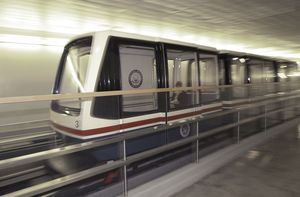
The opening of a third Senate office building in 1982 (named for Michigan senator Phillip Hart) placed new strains on the system and led to a major overhaul. Initially, the existing line that served the Dirksen Building was simply extended to reach the Hart Building, but the 50 senators with offices in the Hart Building were served by only one rail car, often leading to excessive wait times. In 1987 Architect of the Capitol George White proposed construction of a new, state-of-the-art automated magnet-powered subway line to serve the Dirksen and Hart Buildings. The new system, modeled after a railway installed at Walt Disney World in Orlando, Florida, was estimated to cost $10 million but promised to be less expensive to maintain than the existing line. Some senators initially balked at the price tag, but grumblings about long waits and missed votes—senators had just 15 minutes to cast their votes—led to more support. When eight senators missed a vote on February 2, 1988, due to congestion on the subway line, Senator Howell Heflin of Alabama took to the Chamber floor to complain that “from an engineering, mathematical, mileage, [and] measurement basis,” the Hart car could not make enough trips in 15 minutes to ensure all senators made votes in time. Majority Leader Robert Byrd of West Virginia vowed to take the issue up with the Architect of the Capitol, and soon the Senate approved construction of the new system.8
The new automated line began operating in 1994, with enclosed cars running along a “pinched loop.” (The Russell Building line remained intact.) The new system—with three-car trains that could whisk 25 people at speeds of 14 miles per hour—cut wait times down to a minute and reduced the time to travel the 1,600 feet from the Hart Building to the Capitol to less than two minutes. This modern line also had the added benefit of being wheelchair accessible. Today, no visit to the Senate is complete without a ride on the Senate subway.9
Notes
8. “Architect Wants Driverless Senate Subway,” Roll Call, June 1, 1987, 13; Congressional Record, 100th Cong., 2nd sess., February 2, 1988, 631–32; “Senate Subway Improvement on Track,” Washington Post, August 22, 1989, A11; “Construction of $18 Million Senate Subway Begins,” Roll Call, June 3, 1993, 3.